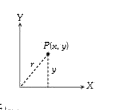The electric potential at a point (x,y) in the x-y plane is given by V=−kxy. The field intentisy at a distance r in this plane, from the origin is proportional to
r2
r
1/r
1/r2
The correct Answer is:B
V=−kxy
⇒→E=−(∂V∂xˆi+∂V∂yˆj×∂V∂zˆk)
=−(−kyˆi−kxˆj+0)
⇒→E=kyˆi+kxˆj
⇒∣∣→E∣∣=k√x2+y2=kx⇒∣∣→E∣∣∝r

Similar Questions
The potential in an electric field varles as v= (x^(2) -y^(2)) . The electric lines of the force in x-y plane are
View Solutionx−y तल में किसी बिन्दु (x,y) पर विद्युतीय विभव V=−kxy द्वारा दिया गया है | मूल बिन्दु से दूरी पर विद्युत क्षेत्र की तीव्रता निम्न रूप में परिवर्तित होती है
View Solutionxy-समतल में बिन्दु (x,y) पर वैद्युत विभव दिया गया है, V=−Kxy वैद्युत क्षेत्र की तीव्रता में मूल बिन्दु से दूरी r के साथ परिवर्तन इस प्रकार होता है।
View SolutionIf the perpendicular distance of a point A, other than the origin from the plane x+y+z=p is equal to the distance of the plane from the origin, then the coordinates of p are
View SolutionThe electric field in a region is directed outward and is proportional to the distance r from the origin, Taking the electric potential at origin to be zero,
View SolutionThe electric potential at a point (x,y) in the x-y plane is given by V=-kxy . The field intentisy at a distance r in this plane, from the origin is proportional to
View SolutionThe potential field depends on x and y coordinates as V=(x2−y2) Corresponding electric field lines in x−y plane are as
View SolutionThe electirc potential at a point (x,y,z) is given by
V=−x2y−xz3+4
The electric field →E at that point is
View Solution
